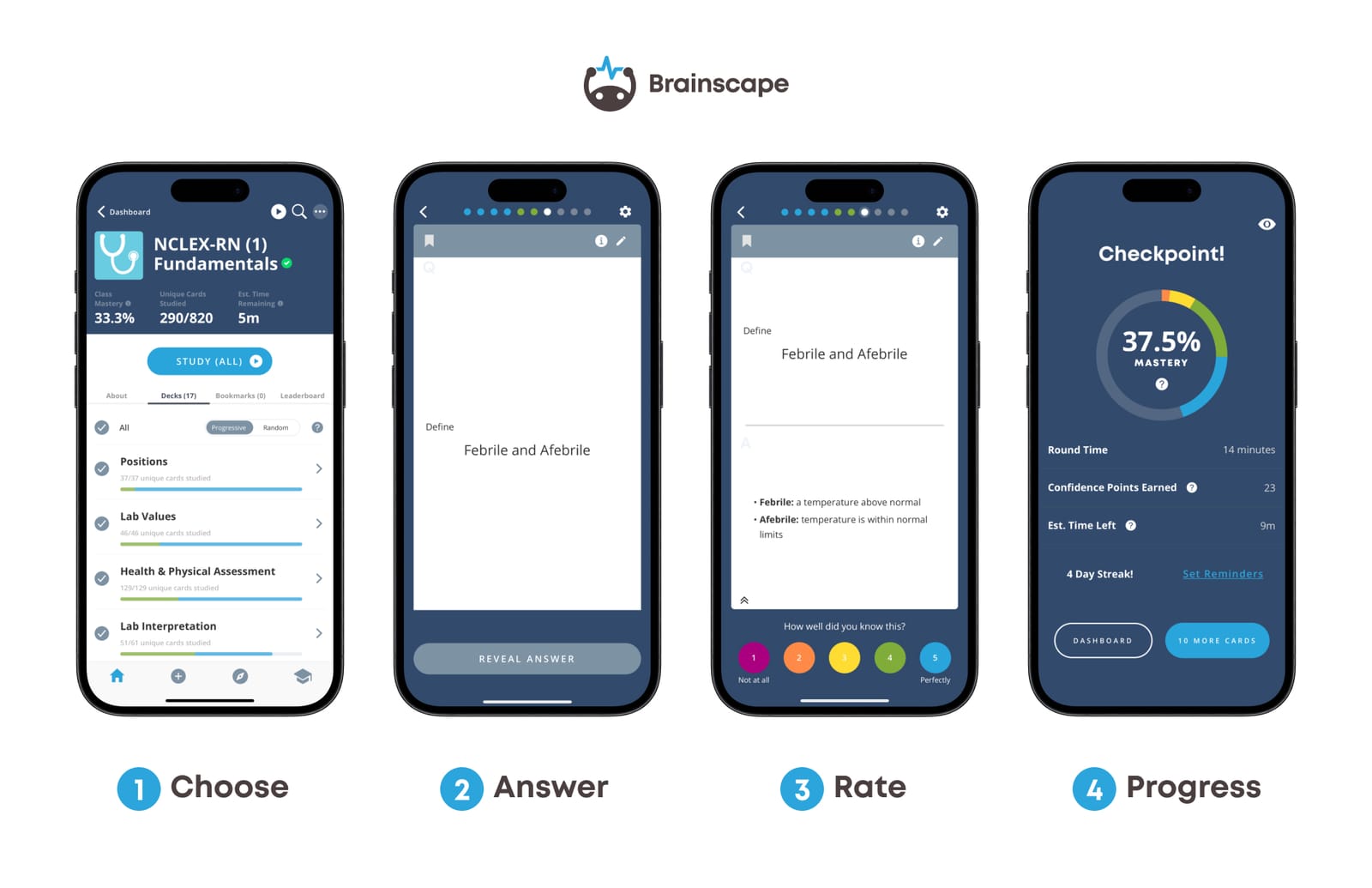Registered nurses (RNs) and Licensed Practical Nurses (LPNs) may have different roles and responsibilities within the clinical work environment but they both need to run the gauntlet of the National Council Licensure Examination or NCLEX before they can become employed. The question is: what IS the difference between the NCLEX RN and the PN exam?
What’s The Difference Between A Registered And Licensed Practical Nurse?
Both registered (RNs) and practical nurses (LPNs) work independently and as part of a healthcare team to provide safe, effective, and ethical care for patients, families, and communities. The key differences between RNs and LPNs lie in the:
- Depth and breadth of knowledge covered in their education,
- Competencies and skills developed during training, and
- Expectations for clinical practice.
LPNs may care for people of all ages, but those patients are typically in a stable or predictable state of health. With additional education, training, and/or supervision, they may also care for those with more complex healthcare needs.
RNs, on the other hand, have more comprehensive education, so they can provide care for patients of all ages in both stable and unstable, complex, or unpredictable conditions. RNs also enjoy additional responsibilities in clinical practice, advanced clinical decision-making, and the utilization of health research.
Now, how do these differences manifest themselves on the NCLEX RN and PN exams?
- LPNs can be asked questions about collecting data, but not assessing it | RNs collect and assess data
- LPNs can only delegate to Unlicensed Assistive Personnel (UAPs) | RNs can delegate to both UAPs and LPNs
- PNs don't typically administer blood or Parenteral Nutrition (TPN), but they will monitor for complications. For IV therapy, they will give IV fluids and monitor for complications | RNs will see NCLEX questions on administering and monitoring blood, TPN, and IV therapy.
Now, let’s look at some of the similarities between the NCLEX RN and PN examinations …
The Similarities Between The NCLEX RN And PN Exam
The NCLEX for practical nurses (PN) and registered nurses (RN) essentially works the same and tests virtually the same nursing content, with minor differences we’ll talk about in this guide. Moreover, each section of the test plan carries about the same weighting or percentage mark allocation for each, as you’ll see in the following pie charts from the NCSBN.org website:
As you can see from these diagrams, the NCLEX exams for practical and registered nurses test the same nursing content and have essentially the same mark allocation for each section. What this means is that the NCLEX RN and PN are very similar.
Additionally, students can receive the same number of questions on each of the exams (between 85 and 150). The exams themselves are computer-adapted, meaning that if you're doing well, you'll get fewer questions. However, if you're still struggling to pass some of the sections mentioned in the above pie charts, you'll continue to get questions.
But, like identical twins, there are still important differences between the NCLEX RN and PN to be recognized, so let’s now take a look at those …
Important: Read the NCSBN’s official NCLEX RN test plan (2023) or NCLEX PN test plan (2023) to understand exactly what to expect from either examination. Remember, in April 2023, the NCSBN introduced a new generation of exam questions called Next Generation NCLEX.
The Differences Between The NCLEX RN And PN Exam
Given the same nursing content, subject weighting, and number of questions, what is the difference between the NCLEX RN and PN test plans?
Well, if you were to dig into the various sections of the test plan for both RN and PN, you’ll discover some specific differences that—because Brainscape is all about making your life easier—we’ve gone to the trouble of highlighting for you, section by section...
Section 1: Management Of Care Vs. Coordinated Care
The RN test calls the first section “Management of Care”, whereas the PN test calls it “Coordinated Care”. Both sections, however, include the same content.
Within that section, the heading “Case Management” on the NCLEX RN test is the equivalent of “Resource Management” on the PN test. Both test the same content.
Similarly, “Assignment, Delegation and Supervision” (RN test) is the equivalent of “Client Care Assignments” (PN test). For each test, the questions would be worded differently, for example:
On the NCLEX RN test, a question might read: “Which client would you assess or see first?” whereas on the PN test, it would be worded as: “Which client would be reported to the RN first?” Ultimately, the goal for each question is exactly the same (choose the most unstable client) however, they are phrased differently to reflect the different roles and responsibilities of the two healthcare professionals.
Another example of this is in questions about delegation. On the NCLEX RN exam, there may be questions about delegating to the UAP and LPN, whereas on the PN exam, the same questions will refer to UAP only (since these are the only healthcare professionals LPNs are permitted to delegate to).
Section 2: Safety And Infection Control
Both the PN and RN tests have exactly the same content on this section, so we’ll skip along to the next …
Section 3: Health Promotion And Maintenance
On the NCLEX RN test, the heading “Techniques of Physical Assessment” is the equivalent of “Data Collection Techniques” on the LPN test. The content is exactly the same, but again, the questions may be worded differently.
For example, on the RN test, the word “assess” would be used, whereas on the PN test, they would say “collect data” or "monitor". In reality, it pretty much means the same thing, but again, LPNs aren’t required to “assess” on the NCLEX PN exam.
Section 4: Psychosocial Integrity
There are a couple of differences in the wording of the topics; however, both tests include the same content.
Section: 5: Basic Care And Comfort
This section is exactly the same for both the NCLEX RN and PN exams.
Section 6: Pharmacological And Parenteral Therapies
On the NCLEX PN and RN test, there is mention of blood, central venous access devices, total parenteral nutrition, or IVs.
Remember, PN don't typically administer blood or Parenteral Nutrition (TPN), but they will monitor for complications. For IV therapy, they will give IV fluids and monitor for complications. RNs, on the other hand, will see NCLEX questions on administering and monitoring blood, TPN, and IV therapy.
Section 7: Reduction Of Risk Potential
This section is the same for both the NCLEX RN and PN exams.
Section 8: Physiological Adaptation
This section is the same for both the NCLEX RN and PN exams.
The Best Way To Study For The NCLEX LPN And RN Exam
What we’ve just established with the above overview is that, essentially, the NCLEX RN and PN exams test the same nursing content with very few exceptions.
So, what’s the best way to study for the NCLEX?
Firstly, know your course content. There's a heap to memorize, and you need efficient tools and systems. Digital flashcard apps like Brainscape and Memrise are the fastest way to memorize information, and are proven to enormously increase the speed at which students learn medical information.

Next, apply this knowledge to practice questions. You need to get used to the question format, learn how to extract the important details, and then prioritize relevant actions.
If you complete regular flashcard review and NCLEX practice questions, you'll thoroughly conquer the NCLEX PN or RN exam, whichever you intend to take!
**NCLEX-RN® is a registered trademark of the National Council of State Boards of Nursing (NCSBN), which neither sponsors nor endorses this product.
Additional Reading
- How to study medications for the NCLEX
- The best way to use NCLEX practice questions
- Does it matter which nursing school you attend?
References
Home. NCLEX. (n.d.-a). https://www.nclex.com/
Kerfoot, B. P. (2010). Adaptive spaced education improves learning efficiency: A randomized controlled trial. Journal of Urology, 183(2), 678–681. https://doi.org/10.1016/j.juro.2009.10.005
NCSBN launches Next Generation Nclex Exam. NCSBN. (n.d.). https://www.ncsbn.org/news/ncsbn-launches-next-generation-nclex-exam
Top NCLEX practice questions you should study. Nurse.org. (n.d.-b). https://nurse.org/education/nclex-practice-questions/
What are the differences between an RN and an LPN?. Nurse.org. (n.d.-c). https://nurse.org/resources/rn-vs-lpn/
